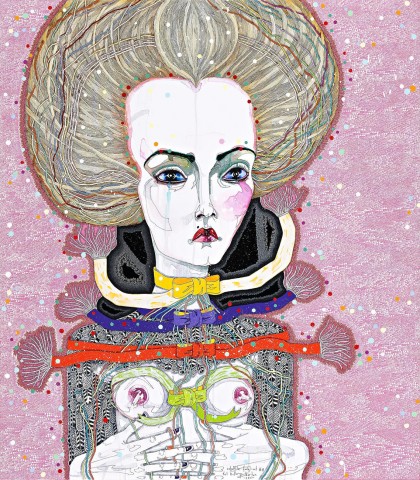SATELLITE FADE-OUT 8, 2011
DEL KATHRYN BARTON
synthetic polymer paint, gouache, watercolour and ink on polyester canvas
160.0 x 140.0 cm
signed, dated and inscribed with title lower centre: satellite fade-out #8 / del kathryn barton / - 2011 -
signed, titled and inscribed on stretcher bar verso: del kathryn barton / - 2011 - / title - satellite fade-out / #8 / ...
Roslyn Oxley9 Gallery, Sydney (label attached verso)
Private collection, Melbourne, acquired from the above in 2011
Del Kathryn Barton, satellite fade-out, Roslyn Oxley9 Gallery, Sydney, 14 July – 6 August 2011, cat. 11
‘I have a face, but a face is not what I am. Behind me lies a mind, which you do not see but which looks out on you. This face, which you see but I do not, is a medium I own to express something of what I am. Or so it seems till I turn to the mirror’.1
With their grand scale, restricted palette and meticulous patterning, Del Kathryn Barton's acclaimed 'satellite fade-out' series of fantastical, feathered females from another world is arguably among her most impressive to date. Departing from the ambiguous figure and nature compositions of previous years, the artist consciously embarked upon this group of courtly women as an opportunity to explore individual variants within a serial format. Strongly reminiscent of the stiff, imperious females of Renaissance portraiture (specifically, the work of Italian mannerist painter Bronzino) in their upright regal carriage, high intelligent forehead and stern demeanour, Barton's sitters also share affinities with the highly decorative art of Gustav Klimt in the positioning of their hands and shape of their hair (more mane than coiffure), while the large watery eyes and use of bright colour unmistakably evoke the illustrations of Japanese manga comics. For all their sisterly resemblances which suggest a family or tribe, however, each remains distinctly different with her own indelible personality: one appears pensive, another more anxious, yet another ecstatic as her head is tilted and eyes averted.
Their eyes blinded with liquid colour, these ‘visionaries’ look both inward and outward – voyaging beyond the mundane towards knowledge of a more cosmic or alien realm, as implied by the galaxies of minute dots constituting the 'satellite fade-out' of the paintings' backgrounds. Consistent with this ‘otherworldliness’, each is feathered, signaling, as Julie Ewington astutely observes, that ‘they are in some unspecified way mythological creatures, as wingedness is always a sign of past or potential transformation, and of the possibility of moving from one world or state to another’.2 For Barton, moreover, the feather motif inextricably links the series with her exquisite suite of works inspired by Oscar Wilde's beautiful fairytale, 'The Nightingale and the Rose' – suggesting ‘... a shiver, movement in wings, a sense of movement, pleasure, adornments less for the other and more for the self, for the pleasure of being embodied’.3 It intrigues her to imagine what the feathers would look like if they started moving – growing beyond what is comfortable.
Far removed from the labyrinthine dream world of her ‘Girl’ series, the protagonist in satellite fade-out 8, 2011 is mature, empowered, imperial. Described by the artist as ‘her companions in a proportional sense’,4 indeed these queenly women bear more in common with Barton's monumental portrait of Cate Blanchett and her children mother (a portrait of Cate), 2009, which was selected as a finalist for the Archibald Prize 2009. Like the actress, arguably the most influential woman working in the arts in Australia today, the grand dames from this unspecified race are depicted absorbed in creation of their own face – bearing a majestic aloofness, they are simultaneously posed and poised, female and feminine, powerful and beautiful.
1. Bell, J., Introduction to 500 Self-Portraits, Phaidon Press, London, 2004, p. 5
2. Ewington, J., Del Kathryn Barton, Piper Press, Sydney, 2014, p. 67
3. Barton, quoted in ibid., p. 68
4. ibid.
VERONICA ANGELATOS
